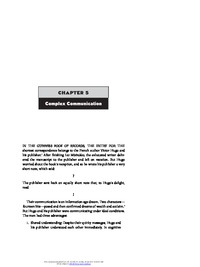Complex CommunicationFrank Levy, Richard Murnane
Zu finden in: The New Division of Labor, 2004
|
 |
 Diese Seite wurde seit 7 Jahren inhaltlich nicht mehr aktualisiert.
Unter Umständen ist sie nicht mehr aktuell.
Diese Seite wurde seit 7 Jahren inhaltlich nicht mehr aktualisiert.
Unter Umständen ist sie nicht mehr aktuell.
 Zusammenfassungen
Zusammenfassungen
 In this chapter, we have described situations in which successful complex communication requires the exchange of vast amounts of verbal and nonverbal information. The information flow is constantly adjusted as the communication evolves unpredictably. For the foreseeable future, computers cannot handle this task. And yet computers are present in almost all the stories. When Roger Perron was not talking to customers, he was working with computer-assisted design tools. As Darcia talked to Betty, she was using a database to check the size of the sweatpants Betty had last ordered, to confirm item availability, and finally to enter Betty’s new order. Fred Hartigan and Dan Lundgren kept all their client information in computerized files.
In this chapter, we have described situations in which successful complex communication requires the exchange of vast amounts of verbal and nonverbal information. The information flow is constantly adjusted as the communication evolves unpredictably. For the foreseeable future, computers cannot handle this task. And yet computers are present in almost all the stories. When Roger Perron was not talking to customers, he was working with computer-assisted design tools. As Darcia talked to Betty, she was using a database to check the size of the sweatpants Betty had last ordered, to confirm item availability, and finally to enter Betty’s new order. Fred Hartigan and Dan Lundgren kept all their client information in computerized files.These situations are all examples of complementarity: computers carrying out rules-based parts of jobs so that skilled people can concentrate on the nonroutine parts. We can be quite sure that this combination leads to better performance (higher quality or lower cost) than exclusive reliance on computers to do the work, because these situations all occurred in competitive markets, environments largely devoid of sentimentality. If a website alone could have answered all of Betty’s questions and given her necessary reassurance, Lands’ End would have been happy to use it. The very existence of a Lands’ End “Live" icon on ist website - the icon that began the phone conversation - signals a need that runs through sales, management, teaching, design and hundreds of other occupations: a need for the capability to interpret subtleties and deliver convincing responses. In an economy flooded with unfamiliar information, communicating complex information effectively is an increasingly important set of human skills.
 Dieses Kapitel erwähnt ...
Dieses Kapitel erwähnt ...
 Personen KB IB clear | John Seely Brown , Joseph Weizenbaum | ||||||||||||||||||
 Begriffe KB IB clear | Arbeitwork
,  Chatbot Chatbot chat bot
, chat bot
,  Computer Computer computer
, computer
,  Eliza Eliza Eliza
, Informationinformation
, Eliza
, Informationinformation
,  Kommunikation Kommunikation communication
, communication
,  Komplementarität Komplementarität complementarity complementarity
| ||||||||||||||||||
 Bücher |
|
 Tagcloud
Tagcloud
 Zitationsgraph (Beta-Test mit vis.js)
Zitationsgraph (Beta-Test mit vis.js)
 Volltext dieses Dokuments
Volltext dieses Dokuments
 |  Complex Communication: Artikel als Volltext ( Complex Communication: Artikel als Volltext ( : :  , 120 kByte; , 120 kByte;  : :  2020-11-28) 2020-11-28) |
 Anderswo suchen
Anderswo suchen 
 Beat und dieses Kapitel
Beat und dieses Kapitel
Beat hat Dieses Kapitel während seiner Zeit am Institut für Medien und Schule (IMS) ins Biblionetz aufgenommen. Beat besitzt kein physisches, aber ein digitales Exemplar. Eine digitale Version ist auf dem Internet verfügbar (s.o.). Es gibt bisher nur wenige Objekte im Biblionetz, die dieses Werk zitieren.








 Biblionetz-History
Biblionetz-History